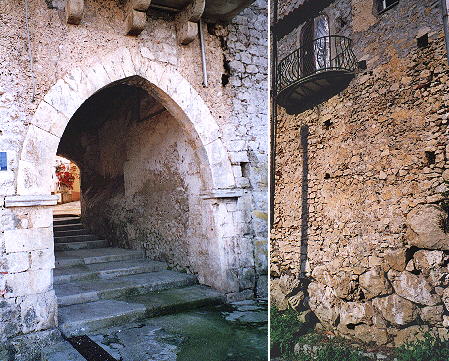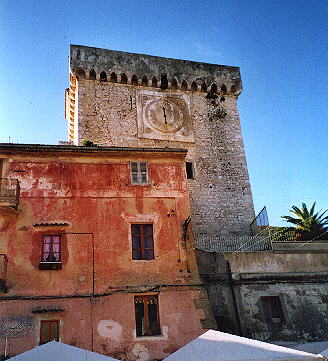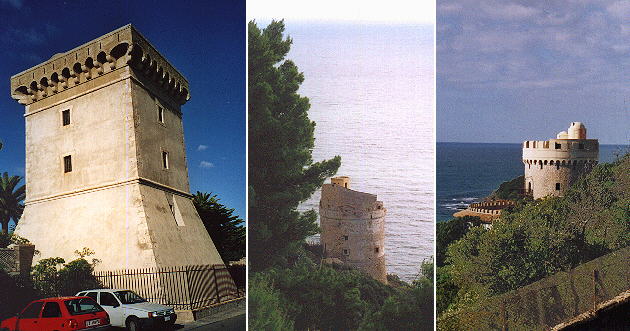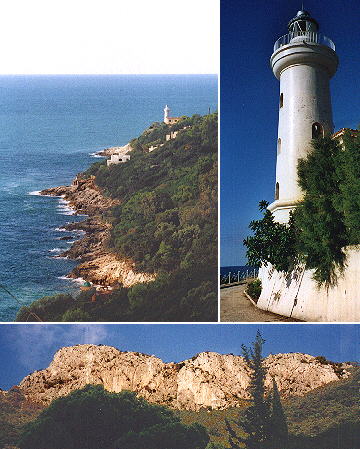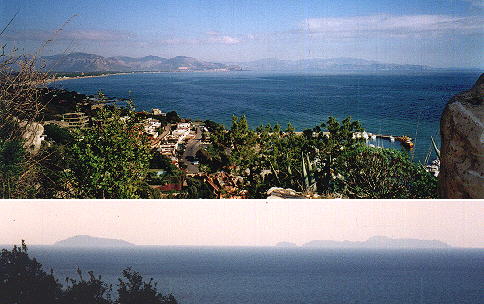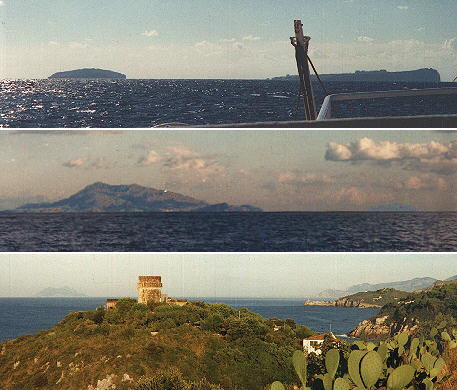

Ferdinand Gregorovius' Walks - San Felice
The charm of Monte Circeo lies in the myth of Circe, the witch-goddess skilled in all enchantments, but with little love for
human-kind. She reigned over the death-island of Aeaea and she was involved in two great Greek myths: Jason and Odysseus. In
the myth of Jason, Aeaea is located at the head of the Adriatic not far from the mouth of the Po (maybe Lussino in Istria); in
the myth of Odysseus, Aeaea is located in the Tyrrhenian Sea and the Roman tradition identified Monte Circeo as
the residence of Circe. Gregorovius mentions many times several aspects of the myth of Circe, which I summarize here below following Robert Graves's account of Odysseus's meeting with Circe (The Greek Myths - Penguin Books - 1955):
"Odysseus (who was escaping from the land of the Laestrygones with a sole vessel) after a long voyage reached Aeaea,
the Island of Dawn, ruled over by the goddess Circe, daughter of Helius and Perse and thus sister to Aeetes, king of Colchis. When lots were cast to decide
who should stay to guard the ships and who should reconnoitre the island, Odysseus's mate Eurylochus was chosen to go ashore with
twenty-two others. He found Aeaea rich in oaks and other forest trees, and at last came upon
Circe's palace, built in a wide clearing towards the centre of the island. Wolves and lions prowled
around her, but instead of attacking Eurylochus and his party, stood upright on their hind legs and caressed them. One might have taken
these beasts for human beings, and so indeed they were,
though thus transformed by Circe's spells.
Circe sat in her hall, singing to her loom and,
when Eurylochus's party raised a halloo, stepped out with a smile and invited them to dine at her table. All entered gladly, except
Eurylochus himself who, suspecting a trap, stayed behind and peered anxiously in at the windows. The goddess set a mess
of cheese, barley, honey, and wine before the hungry sailors; but it was drugged, and no sooner had they begun to eat than
she struck their shoulders with her wand and transformed them into hogs. Grimly then she opened the
wicket of a sty, scattered a few handful of acorns and cornel-cherries on the miry floor, and left them there to wallow.
Eurylochus came back, weeping, and reported this misfortune to Odysseus, who seized his sword and went off,
bent on rescue, though without any settled plan in his head. To his surprise he encountered the god
Hermes, who greeted him politely and offered him a charm against Circe's magic: a scented white flower with a black
root, called moly, which only the gods can recognize and cull. Odysseus accepted the gift gratefully and,
continuing on his way, was in due course entertained by Circe. When he had eaten his drugged
meal , she raised her wand and struck him on the shoulder. 'Go join your comrades in the sty', she commanded. But having surreptitiously smelt
the moly flower, he remained unenchanted, and leaped up, sword in hand. Circe fell weeping at his feet. 'Spare me', she cried, 'and you shall
share my couch and reign in Aeaea with me!'. Well aware that witches have power to enervate and
destroy their lovers, by secretly drawing off their blood in little bladders, Odysseus exacted a solemn oath
from Circe not to plot any further mischief against him. This oath she swore by the blessed gods and, after giving him a
deliciously warm bath, wine in golden cups, and a tasty supper served by a staid housekeeper, prepared
to pass the night with him in a purple coverleted bed. Yet Odysseus would not respond to her amorous advances until she consented
to free not only his comrades but all the other sailors enchanted by her. Once this was done, he gladly stayed in Aeaea until she had
borne him three sons, Agrius, Latinus and Telegonus."
Latinus is the link between the Greek and the Roman myths, as he was the ancestors of the Latins.
San Felice and Monte Circeo were populated very early as the many caves in the area provided
shelter while the sea and the forest provided food and timber (a Neanderthal man's skull was recently
found in a cave near San Felice). San Felice retains the square shape of the Roman castrum, which mostly
likely replaced a previous Volscan town as suggested by traces of polygonal walls.
The Old Gate and remains of the polygonal walls
In medieval times the southern coast of Latium, although belonging to the Papal state, was mainly
populated by fishermen from Naples, Amalfi and Sicily and even in the XIXth century, as Gregorovius notes in his description
of Anzio, Neapolitan fishermen still used to feel
at home in this area. The influence of Sicilian architecture (a mixture of Gothic and Arabic architectures) is evident
in the only old gate of San Felice and in the Caetani Palace (the background of this page elaborates on
a decoration of the tower).
Tower of Palazzo Caetani
The coastline of Monte Circeo offered an advanced
point of observation for the early identification of threats (from the Saracens and Turkish pirates and corsairs to
the XIXth century followers of Mazzini and Garibaldi): so it is not surprising
to see so many watch towers around San Felice. Unfortunately some of them were included in
posh villas built in the 1950s and can be seen only at a distance.
Torre Vittoria, Torre del Fico and Torre Cervia
San Felice is the starting point of several walks leading to the Acropolis, to the lighthouse and to
several caves. Although the excess of private property
which was allowed in the 1950s limits in part the view over the sea and the mountain, these walks
give great enjoyment especially if made in winter, when the sun reflected by the white cliffs and by the sea makes you feel
already in spring.
The lighthouse and the white rocks of Capo Circeo
The Italian peninsula does not have many islands and in particular historical Latium did not have any island. It is only
from Monte Circeo that it is possible to see the islands which all belonged to the kingdom of Naples. The nearest one is Ponza
surrounded by islets.
View towards Terracina and Gaeta - The islands of Zannone and Ponza
It is more difficult to see Ventotene and Santo Stefano as they are very small and rather flat, while on clear days it is easier to see the profiles of Monte Epomeo (Ischia) and Monte Solaro (Capri). Monte Circeo itself
appears as an island when seen at a distance.
The islands of S. Stefano and Ventotene (seen from the ferry) -
Ischia and Capri (seen from Ventotene) - Mount Circeo and Terracina (seen from Torre Viola near Gaeta)
With all these islands Odysseus must have felt at home at Circe's palace!
In this account Gregorovius briefly described also Terracina.
Introductory page on Ferdinand Gregorovius
Other walks:
The Roman Campagna:
Palestrina
Genazzano
Paliano
Anagni
The Ernici Mountains:
Ferentino
Alatri
From Anzio to Torre Astura:
Anzio
Nettuno and Torre Astura
The Volsci Mountains:
Valmontone and Colonna
Segni
Norma
Cori
The Orsini Castle in Bracciano
Subiaco, the oldest Benedictine monastery
See my Home Page on Baroque Rome or my
Home Page on Rome in the footsteps of an
XVIIIth century traveller.
|


